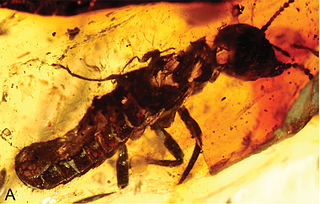Related Research Articles
Michael S. Engel, FLS, FRES is an American paleontologist and entomologist, notable for contributions to insect evolutionary biology and classification. In connection with his studies he has undertaken field expeditions in Central Asia, Asia Minor, the Levant, Arabia, eastern Africa, the high Arctic, and South and North America, and has published more than 760 papers in scientific journals and over 800 new living and fossil species. Some of Engel's research images were included in exhibitions on the aesthetic value of scientific imagery. Engel is the author of Innumerable Insects and co-author of Evolution of the Insects.

Mastotermitidae is a family of termites with one sole living species, Mastotermes darwiniensis which is found only in northern Australia. The remaining genera of this family are only known from the fossil record.

Dampwood termites constitute a small and rather primitive family Termopsidae (Latin) of termites (Isoptera). They contain four or five extant genera with 13–20 living species, but can be divided into several subfamilies. They may be a nuisance, but compared to the drywood termites (Kalotermitidae), usually do not cause extensive damage to buildings or other man-made structures. As their name implies, they eat wood that is not dried out, perhaps even rotting, and consequently of little use to humans.

Prostylotermes is an extinct genus of termite in the isopteran family Stylotermitidae known from two Eocene fossils found in India. The genus contains a single described species, Prostylotermes kamboja.

Parastylotermes is an extinct genus of termite in the Isoptera family Stylotermitidae known from North America, Europe, and India. The genus contains five described species, Parastylotermes calico, Parastylotermes frazieri, Parastylotermes krishnai, Parastylotermes robustus, and Parastylotermes washingtonensis.

Mastotermes is a genus of termites. The sole living species is Mastotermes darwiniensis, found only in northern Australia. A number of extinct taxa are known from fossils. It is a very peculiar insect, the most primitive termite alive. As such, it shows notable similarities to certain cockroaches, the termites' closest relatives. These similarities include the anal lobe of the wing and the laying of eggs in bunches, rather than singly. The termites were traditionally placed in the Exopterygota, but such an indiscriminate treatment makes that group a paraphyletic grade of basal neopterans. Thus, the cockroaches, termites and their relatives are nowadays placed in a clade called Dictyoptera.
Zootermopsis laticeps, known generally as Arizona dampwood termite, is a species of termite in the family Archotermopsidae. Other common names include the wide-headed rottenwood termite and southwestern rottenwood termite. It is found in Central America and North America.
Gnathamitermes perplexus, the long-jawed desert termites, is a species of termite in the family Termitidae. It is found in Central America and North America.
Gnathamitermes is a genus of termites in the family Termitidae. There are about six described species in Gnathamitermes.
Reticulitermes hageni, the light southeastern subterranean termite, is a species of termite in the family Rhinotermitidae. It is found in North America.
Reticulitermes hesperus, the western subterranean termite, is a species of termite in the family Rhinotermitidae. It is found in Central America and North America.
Neotermes castaneus, known generally as the southern damp-wood termite or Florida dampwood termite, is a species of termite in the family Kalotermitidae. It is found in the Caribbean Sea, Central America, North America, and South America.
Marginitermes hubbardi, the light western drywood termite, is a species of termite in the family Kalotermitidae. It is found in Central America and North America.
Marginitermes is a genus of termites in the family Kalotermitidae. There are at least three described species in Marginitermes.
Tenuirostritermes cinereus is a species of termite in the family Termitidae. It is found in Central America and North America.
Tenuirostritermes is a genus of termites in the family Termitidae. There are about five described species in Tenuirostritermes.
Stolotermitidae is a family of termites in the order Blattodea. There are about 14 described species in Stolotermitidae.
Stylotermitidae is a family of termites in the order Blattodea. There are two extinct and one extant genera in Stylotermitidae, with more than 50 described species.
Archeorhinotermes is an extinct genus of termites in the family Archeorhinotermitidae, and is the sole genus of the family. There is one described species in Archeorhinotermes, A. rossi. It was discovered in Burmese amber.
Cratomastotermes is an extinct genus of termites in the family Cratomastotermitidae, the sole genus of the family. There is one described species in Cratomastotermes, C. wolfschwenningeri.
References
- 1 2 3 Engel, Michael S.; Grimaldi, David A. (2011). "Kumar Krishna, in appreciation". ZooKeys (148): 1–13. doi:10.3897/zookeys.148.2008. PMC 3264412 . PMID 22287887.
- ↑ "Kumar Krishna. Obituary". The New York Times. 2014-09-28.